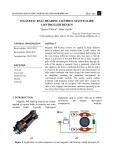
P-ISSN 1859-3585 E-ISSN 2615-9619 https://jst-haui.vn SCIENCE - TECHNOLOGY Vol. 60 - No. 9 (Sep 2024) HaUI Journal of Science and Technology 103
VIBRATION SUPPRESSION CONTROL FOR 5-DOF VARYING-CABLE-LENGTH TOWER CRANES
ĐIỀU KHIỂN CHỐNG RUNG CHO CẦN TRỤC THÁP 5 BẬC TỰ DO CÓ CHIỀU DÀI CÁP THAY ĐỔI Nguyen Huu Hai1, Bui Tung Duong2, Nguyen Thi Trang2, Quach Duc Cuong1, Duong Minh Duc2,* DOI: http://doi.org/10.57001/huih5804.2024.302 1. INTRODUCTION A tower crane is a type of lifting device with a tower body that rapidly increases from tower sections to the height of the building, with a very large reach [1]. It is widely used for material transportation and assembly in factories, civil construction works, industrial construction, and hydroelectric projects, etc. [2]. However, reality presents major challenges to tower crane operations. Occupational accidents still occur regularly, serious safety accidents of cranes have caused casualties and property loss [3]. One of the main causes of this phenomenon is load vibration during operation. During the tower crane's operation, its movement causes vibrations inside the structure. The faster the crane moves, the greater the moment of inertia it generates [4]. In addition to moving with the crane, inertial forces will cause relative movement of the load with respect to the crane, causing swing angles of the load cable around its equilibrium position [5]. This phenomenon not only
ABSTRACT
Tower crane is widely used in
various fields such as construction, industry, transportation, etc. The tower
crane, by its physical nature, is a oscillating pendulum in space, thus the vibrations of the load are inevitable
during operation, highlighting the necessity of researching vibr
ation control methods for tower cranes. Most
current studies on anti
-
vibration for tower cranes focus on the object with a fixed cable length and 4 degrees
of freedom, while research on anti
-vibration for 5 degrees of freedom tower cranes is still limited.
This article
presents a sliding mode control (SMC) method for vibration control of a 5 degrees of freedom tower crane
with variable cable length. The control system, with high robustness, helps move the load along the desired
trajectory while effectively
suppressing vibrations. The feasibility and effectiveness of the proposed control
method are tested through simulations.
Keywords: Tower cranes, sliding mode control, varying cable length.
TÓM T
ẮT Cần trục tháp giữ là một trong các thiết bị nâng hiện đại được sử dụng trong ngành xây dựng, đáp ứ
ng
nhu c
ầu vận chuyển vật liệu xây dựng một cách chính xác và hiệu quả. Vì cẩu tháp có bản chất vật lý là một hệ
con l
ắc dao động trong không gian, do đó, khó tránh khỏi các rung động của tải trong quá trình vậ
n hành.
Đi
ều này đặt ra yêu cầu trong việc nghiên cứu các phương pháp điều khiển chống rung cho cẩu tháp, nhằ
m
gi
ảm thiểu hiện tượng rung động và đảm bảo sự ổn định trong quá trình vận hành. Hầu hết các nghiên cứ
u
ch
ống rung cẩu tháp hiện nay tập trung vào đối tượng cẩu tháp có chiều dài dây cáp là cố định với 4 bậc tự
do,
các nghiên c
ứu về chống rung cho cẩu tháp 5 bậc tự do còn rất hạn chế. Bài báo này trình bày ph
ương pháp
đi
ều khiển chống rung cho cần trục tháp 5 bậc tự do với chiều dài cáp thay đổi sử dụng phương pháp điề
u
khi
ển trượt (sliding mode control - SMC). Bộ điều khiển có tính bền vững cao giúp di chuyển tải theo quỹ đạ
o
mong mu
ốn, đồng thời triệt tiêu rung động một cách hiệu quả. Hiệu quả của phương pháp đề xuất được kiể
m
nghi
ệm qua các mô phỏng. Từ khóa: Cần trục tháp, điều khiển trượt, chiều dài cáp thay đổi.
1
Faculty of Faculty of Electrical Engineering, Hanoi University of Industry, Vietnam
2
School of Electrical and Electronic Engineering, Hanoi University of Science and Technology, Vietnam
*
Email:duc.duongminh@hust.edu.vn
Received: 15/4/2024
Revised: 05/6/2024
Accepted: 27/9/2024

CÔNG NGHỆ https://jst-haui.vn Tạp chí Khoa học và Công nghệ Trường Đại học Công nghiệp Hà Nội Tập 60 - Số 9 (9/2024)
104
KHOA H
ỌC
P
-
ISSN 1859
-
3585
E
-
ISSN 2615
-
961
9
reduces work efficiency but also causes labor safety. Therefore, eliminating vibration of tower cranes during operation is extremely necessary. In recent years, many studies have proposed anti-vibration control methods for tower cranes. The most notable studies include: robust control [6, 7], nonlinear control [8, 9], model predictive control [10, 11], adaptive control [12, 13], etc. In [14], a feedback control method for tower cranes using gain-scheduling technique has been proposed to eliminate load fluctuations, but the nonlinear characteristics of the system are not considered. In [15] an elastic model of tower crane is developed. Then, a two-degree-of-freedom control structure for tower cranes is proposed. The control system combines nonlinear flatness-based control and a linear quadratic regulator. In addition to feedback control methods, several feedforward control methods are also developed for tower cranes. In [16] , a command shaping approach for the radial motion of a tower crane has been proposed. In [17, 18], an optimal trajectory is considered for a tower crane. Most of the above studies have studied tower cranes with 4 degrees of freedom with fixed rope length. To ensure effective completion of transportation and lifting/lowering of loads, it is necessary to consider the change in rope length, therefore, the control method of the 5-degree-of-freedom tower crane needs to be studied further. In addition, the problem of controlling the nonlinear model of tower cranes also needs to be applied. Using a dynamic model close to reality will improve durability as well as the ability to resist disturbances when applied in practice [19]. Sliding mode control (SMC) is a robust and effective control strategy that has found widespread applications in various engineering domains because of its of robustness, fast response, and design simplicity. Therefore, this article proposes the sliding control method (SMC), which essentially uses intermittent feedback control law to enforce system stability, helping to effectively reduce load vibration. First, the system operates as a scaled down system compared to the original object, second, the movement on the sliding surface of the system makes the system insensitive to disturbances and model uncertainty [20]. The article uses a nonlinear dynamic model and considers the change in cable length, ensuring accuracy compared to the actual tower crane model. The results of the method solved the problem of planning the trajectory of a 5-degree-of-freedom tower crane with increasing/decreasing the load, controlling the crane rotation, moving the trolley and changing the cables. The oscillation angles of the load are eliminated almost completely quickly and reach zero before the crane stops completely. 2. TOWER CRANE DYNAMICAL MODEL The tower crane model is described in the static coordinate system Oxyz and rotate coordinate system Oxyz as shown in Fig. 1. The system consists of a trolley with mass m, a load with mass m, and the moment of inertia of the tower body rotation J. There are 5 types of motions: translation of the trolley x, rotatio of the tower body γ, length variation motion of the cable l and swinging motion of the load cable due to oscillation angles θ and θ. Thus, =[ γ,x,l,θ,θ] is chosen as the generalized coordinate vector. The control inputs include the pulling force u, the torque u and the control force for cable length adjustment u to move the trolley, rotate the tower body, and adjust the cable length to reach the destination from the initial position. Fig. 1. Tower crane model l: rope length; x: distance of the trolley from the tower axis; γ: rotation angle of the tower body; θ,θ: oscillation angles of the load; m,m: mass of the load and trolley Using the Lagrange method and after computational steps, we obtain the dynamical model of the tower crane in matrix form as follows [3]: ()+(,)+()= (1) where: () is the inertia symmetric matrix:

P-ISSN 1859-3585 E-ISSN 2615-9619 https://jst-haui.vn SCIENCE - TECHNOLOGY Vol. 60 - No. 9 (Sep 2024) HaUI Journal of Science and Technology 105
()=
⎣
⎢
⎢
⎢
⎡
m m m m m
m m m m m
m m m 0 0
m m 0 m 0
m m 0 0 m
⎦
⎥
⎥
⎥
⎤
(2) The parameters of the elements of the matrix (): m=(m+m)x+ml(θ
+θ
)+2mxlθ+J; m=m=−mlθ; m=m=mxθ; m=m=−mlθ; m = m=ml(x+lθ); m=(m+m); m=m=mθ; m=m=ml; m = m= −mlθθ; m=m; m=m=ml; (,) is the centrifugal and Coriolis matrix. The elements of the matrix are represented as follows: (,)=
⎣
⎢
⎢
⎢
⎡
0
0
0
0
⎦
⎥
⎥
⎥
⎤
(3) The parameters of the elements of the matrix (,): C=2(m+m)xx+2mlxθ; c=(2mlθ
+2mlθ
+2mxθ)γ−2mlθθ+
(2mlθ+2mx)θ; c = (2mxl+2mlθ)γ+mlθθθ; c = (2mlθ−2mxlθθ)γ+2mlθθ
−
mlxθθ; c=−[mlθ+(m+m)x]γ; c= −2mγθ+2mθ−2mθθθ; c=−2mlθθ−mlθθ; c=−2mlγ−mlθθ; c=−(mxθ+mlθ
+mlθ
)γ; c= 2mγθ; c=2mlθγ; c=−2mlγθ−mlθ; c=−ml(x+lθ)γ; c= −2mlγθ+2mlθ; c=−2mlθθ; c = −2mlγ; c=ml(xθθ−lθ)γ; c= 2mlγ; c= 2mlγθ; c=2mlγ+mlθθ; c= 2mll; () represents the gravitational component and represents the control input. ()=
⎣
⎢
⎢
⎢
⎡
0
0
⎦
⎥
⎥
⎥
⎤
,=
⎣
⎢
⎢
⎢
⎡
0
0
⎦
⎥
⎥
⎥
⎤
(4) The elements of the gravitational component G(q) are: g=−mlθ
+mg; g=mglθ; g=mglθ; 3. DESIGNING OF SLIDING MODE CONTROLLER 3.1.Controller designing The purpose of the sliding mode controller (SMC) is to control the state trajectories = [ γ x l] to achieve desired values = [ γ x l] and to drive the oscillation angle of the load = [θ θ] towards = [0 0 ]. A sliding surface first is constructed such that the state trajectories are attracted towards it, then a control law is designed to drive all states to the equilibrium point. Before designing the controller, the equation (1) is rewritten as follows: ()+()+(,)+
(,)+()= (5) ()+()+(,)+
(,)+()=0 (6) where: ()=m m m
m m m
m m m; ()=m m
m m
m m; ()=m m m
m m m; ()=m m
m m; (,)=c c c
c c c
c c c; (,)=c c
c c
c c; (,)=c c c
c c c; (,)=c c
c c; ()=0
0
g; ()= g
g; = u
u
u; Equations (5) and (6) are transformed into the following form: =
()(−()−
(,)−(,)−()+) (7) =
()−()−
(,)−(,)−() (8) It should be noted that () and () are positive definite matrices with parameters l>0, θ<

CÔNG NGHỆ https://jst-haui.vn Tạp chí Khoa học và Công nghệ Trường Đại học Công nghiệp Hà Nội Tập 60 - Số 9 (9/2024)
106
KHOA H
ỌC
P
-
ISSN 1859
-
3585
E
-
ISSN 2615
-
961
9
và θ<
. By substituting (8) into (5), we can derive the following: ()+(,)+(,)+()=(9) where: ()=()−()
()() (,)=(,)−()
()(,) (,)=(,)−()
()(,) ()=−()
()G() The mathematical model (9) will be used to design the tower crane controller. The designing steps are as follows. Step 1: define the sliding surface as: =
=+++ (10) where =−=γ−γ
x−x
l − l ; =−=θ
θ are signal errors. ; ; are controller coefficient matrix, with: =μ 0 0
0 μ 0
0 0 μ; =μ 0
0 μ
0 0; =a 0
0 a
0 0; Derivative of (10) one can obtain: =+++ =++ + (11) Step 2: set =−K.sgn(w), then, the control input is obtained as =(,)+() −()−
()()× −
()(,)+(
−
()(,)−
()() −.sgn() (12) Comment 1: In (16), =diag (K,K,K) is positive definite matrix ensures the sliding surface converges to 0. Furthermore, ,, are selected to stabilize the system and to make the sliding state trajectory converge to the equilibrium point as fast as possible [21]. Sign function sgn () causes chattering around the surface of the state trajectory. To minimize this, a saturation function sat() = [sat(w) sat(w) sat(w)] described in equation (13) as follows to replace the sign function: sat(w)=
⎩
⎨
⎧
+1 if
>1
if − 1<
<1
−1 if
<−1 (13) 3.2. Stability Analysis of the Proposed Controller Control scheme (12) must satisfy two requirements: the controller forces the state trajectories to approach the sliding surface after entering it (necessary condition), and the control law pulls the state trajectories on it towards the equilibrium point (sufficient condition). By choosing such that there exists the inverse of the matrix −
()(), the control law (12) ensures that all trajectories of the system slide to the surface. However, trajectories may not always converge to the equilibrium point when they are on the surface. If the linear surface (10) and the two accelerations (6) are stable, then stability on the surface will be established [21]. To show the system stability the following Lyapunov candidate function is considered: V=
.≥0 (14) Taking the derivative, we obtain: V= (15) Substituting the expressions from equations (7), (8), and (12) into equation (15) and simplifying, we obtain: V=−sat() (16) It is clear that V≤0 for all positive definite constants K. By using the Barbalat's lemma, the values of [ww w ] will tend to [0 0 0] . Therefore, the sliding surface is asymptotically stable, ensuring the condition for stable convergence of the sliding surface. The value of is chosen such that the inverse of the expression for (−
()()) exists. However, stable sliding surface does not lead to stability of the system's output. By using equations (8), (11), and (12), we obtain: =−
()()+(,)
+(,)+() = −
()
⎝
⎛
()()−(,)
−()
+ (,)+(,)
+()
⎠
⎞
=−
()(−()
()()
−
()()
×((-
()(,)) + (-
()(,)) −
()()) +(,)+(,)+())
(17)

P-ISSN 1859-3585 E-ISSN 2615-9619 https://jst-haui.vn SCIENCE - TECHNOLOGY Vol. 60 - No. 9 (Sep 2024) HaUI Journal of Science and Technology 107
Alternatively, it can be summarized as follows: =(,)+(,)+() (18) where (,)=(
()−
()() ×(-
()(,)) -
()(,)) (,)= (
()−
()() ×(-
()(,)) -
()(,q)) ()=−(
()−
()() ×
() +
())() Because the controller obtained in equation (12) must ensure that all state variables of the system reach the sliding surface =0 within a finite time, we consider the case where trajectories reach the sliding surface =0. Using equation (10) with =0,=0 we have: +(−)++=0 (19) Equivalent to: =−(−)−− (20) Let's denote the state variables as follows: =[]=[−] (21) Then, == (22) =()+()+() (23) =−−− (24) Substitute (24) into (23):
=
(
)
(
−
−
−
)
+
(
)
+
(
)
= -() – () – () + ()+() = -() + (()-() ) –
(
)
+
(
)
=
(
)
(25
)
From (21)-(25) one can write: =
()
−−−=() (26) Linearize the system at equilibrium point =0 (or =), we can derive a corresponding linear system as follows: = (27) where: =∂()
∂ = 0× × 0×
∂()
∂∂()
∂∂()
∂
−− − = 0× × 0×
−− − After some computational steps, we obtain the matrices ,, as: =−
⎣
⎢
⎢
⎡
μμ+g
l−α 0
0μμ+g
l−α
⎦
⎥
⎥
⎤
=−μα−μ
l−α 0
0μα−μ
l−α =−
⎣
⎢
⎢
⎢
⎡
λ
l−α 0 0
0λ
l−α 0
⎦
⎥
⎥
⎥
⎤
For the system = to be stable, the linearized matrix must be Hurwitz. The characteristic polynomial of :
det
(
s
−
)
=det
s
−
− s−
0
×
−
s+ =|s+| s−
− s−−
0×
−(s+)[] =(s+λ)
⎝
⎛
s+(μl−μ)
(l−α)s
+g
(l−α)s+ gμ
(l−α)
⎠
⎞
×s+(μl−μ)
(l−α)s
+g
(
l
−
α
)
s+ gμ
(
l
−
α
)
=
(
s
+
λ
)
P
(
s
)
.
Q
(
s
)
(28)
where P(s)=
⎝
⎛
s+(μl−μ)
(l−α)s
+g
(l−α)s+ gμ
(l−α)
⎠
⎞
























![Đề cương đề tài nghiên cứu khoa học [chuẩn nhất/mới nhất]](https://cdn.tailieu.vn/images/document/thumbnail/2025/20251117/duong297/135x160/26111763433948.jpg)

